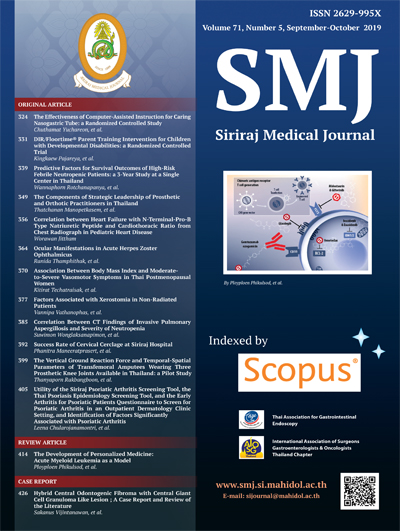The Development of Personalized Medicine: Acute Myeloid Leukemia as a Model
DOI:
https://doi.org/10.33192/Smj.2019.62Keywords:
Acute myeloid leukemia; developing country; precision medicine; targeted therapy; ThailandAbstract
The term personalized medicine has been employed in widely different contexts and has acquired status as one of the most often used keywords recently. In this review we take it to understand the application of modern diagnostic medicine and therapeutics to patient with the purpose of eradicating disease or alleviating symptoms in a manner, where all actions are based on detailed knowledge of the condition of the individual patient. Applying these concepts should lead to optimization of clinical decision-making and, in its utmost consequence, a substantial decrease in costs incurred for hospitalization and follow-up. The latter is based on the evidence that for many disorders “less but more targeted” will mean improved outcome. Acute myeloid leukemia (AML) is the most common acute leukemia in adults and is a major challenge in terms of diagnosis, care, follow-up and therapy. Thus, in population-based analyses, overall survival is only just exceeding 40% with major reasons for treatment failure. For these reasons, AML has been intensely studied during the recent decades. With the development of multiparametric flow cytometry, it allows us to get an accurate diagnosis and immunophenotypic profiles of AML. In addition, there is now an abundance of knowledge regarding its cytogenetic and molecular background. These enable us to follow the amount of disease down to the minutest quantity with a high resolution of molecular details. Finally, based on knowledge of these variables in the single patient cytoreduction is now being refined to therapies targeted to the molecular changes in the patient.
Downloads
Published
How to Cite
Issue
Section
License
Authors who publish with this journal agree to the following conditions:
Copyright Transfer
In submitting a manuscript, the authors acknowledge that the work will become the copyrighted property of Siriraj Medical Journal upon publication.
License
Articles are licensed under a Creative Commons Attribution-NonCommercial-NoDerivatives 4.0 International License (CC BY-NC-ND 4.0). This license allows for the sharing of the work for non-commercial purposes with proper attribution to the authors and the journal. However, it does not permit modifications or the creation of derivative works.
Sharing and Access
Authors are encouraged to share their article on their personal or institutional websites and through other non-commercial platforms. Doing so can increase readership and citations.















